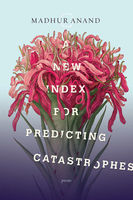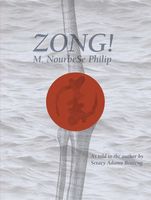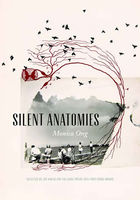Poetic Inspiration I
By Kate Sutherland
Rather than simply providing a list of books that have inspired me, I want to go into a bit of detail on specific poems or series of poems or poetic innovations that have made my synapses crackle, broadened my sense of what poems can be and do, and sparked me to stretch further in my own work. So this will be the first of a series of posts on this topic.
1. Madhur Anand is a professor in the School of Environmental Sciences at the University of Guelph, and her debut collection of poems, A New Index for Predicting Catastrophes, has been described as “lluminat[ing] and celebrat[ing] the intersection of poetry and science.” One innovative way that she does this is by making poems out of her academic papers. For example, “Pine Plantation (An Expansion)” draws upon “Mechanisms of Araucaria (Atlantic) Forest Expansion into Southern Brazilian Grasslands,” an article she co-wrote with L.C.R. Silva and published in a scientific journal. And “Alienation (The Transferring of Title or of Interest” draws upon “The Scientific Value of the Largest Remaining Old-Growth Red Pine Forests in North America.” Many such poems are scattered throughout the collection to brilliant effect. I always want to write poems when I’m reading about science, but these poems by Anand have broken open brand new possibilities for me of ways of interacting with scientific sources, even though I have no scientific papers of my own from which to work.
2. This brings me back to M. NourbeSe Philip’s Zong. I already cited this book as an important influence in my Writers as Readers interview with Open Book, but I want to say a bit more about it here, for in using a legal judgment as her source material, Philip demonstrated the powerful use that can be made in poems of the standard texts of my professional life. The book is a poem sequence about the massacre in 1781 of a ship full of Africans who had been captured and enslaved. This horrific incident gave rise to a famous case, not a murder case, as the people killed were then regarded in English law as chattels rather than human beings, but an insurance case: Gregson v. Gilbert. In composing the poems, Philip limited herself to that text, using the judgment as “a word store,” and, in so doing, literally deconstructing the decision, pulling apart the words with which it is composed, and rearranging them to construct her own text. And somehow, she thereby brings to the fore the voices of the African passengers which were wholly absent from the judgment. Zong! still stuns me every time I read it. And it has provided me with pedagogic as well as poetic inspiration. In my Law and Literature classes, I assign students to make erasure poems from legal judgments, and it can prove enormously empowering for them to take a sharpie pen to a judgment, crossing out bits rather than treating it all as exalted text, and seeing what hidden stories and themes may rise up from what remains.
3. I mentioned that some of my recent work has taken a visual turn. In Silent Anatomies, Monica Ong combines the textual with the visual in seamless fashion with enormous impact. I find everything that she does in this book exhilarating, and recommend that everyone read the whole of it. But I’ll highlight just one particularly striking component here. The book contains a series of poems structured as directions on medicine bottles. On one page, these are laid out in text as standard poems, but on the facing page, they’re pictured on the labels of medicine bottles, heightening the effect of Ong’s chosen form. I’ve learned since reading the book that Ong, a visual artist as well as a poet, has added another level by also creating and exhibiting these bottles as three dimensional objects. Some of these can be viewed on her website here under the heading of "remedies": http://www.monicaong.com/gallery/
That’s three examples to begin, but I have many more to cite, so a few more posts on poetic inspiration will be forthcoming.
Your CanLit News
Subscribe to Open Book’s newsletter to get local book events, literary content, writing tips, and more in your inbox
The views expressed in the Writer-in-Residence blogs are those held by the authors and do not necessarily reflect the views of Open Book.
Kate Sutherland was born in Scotland, grew up in Saskatchewan, and now lives in Toronto, where she is a professor at Osgoode Hall Law School. She is the author of two collections of short stories: Summer Reading (winner of a Saskatchewan Book Award for Best First Book) and All In Together Girls. How to Draw a Rhinoceros is Sutherland’s first collection of poems.
You can reach Kate throughout the month of October at writer@open-book.ca.





